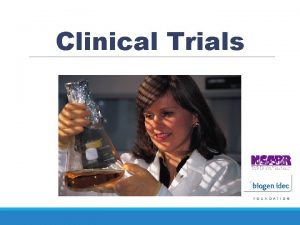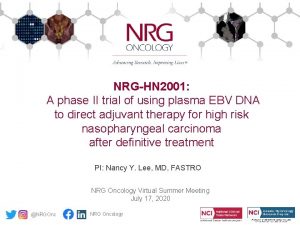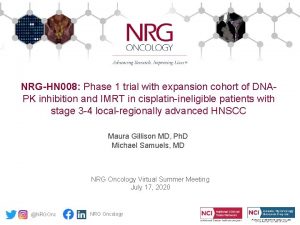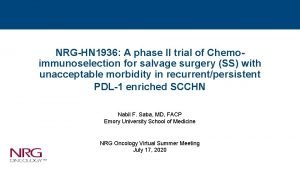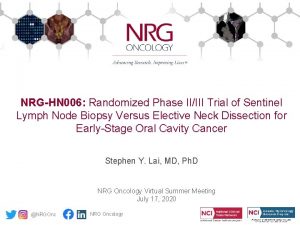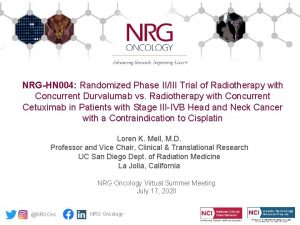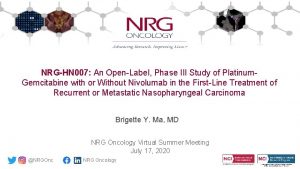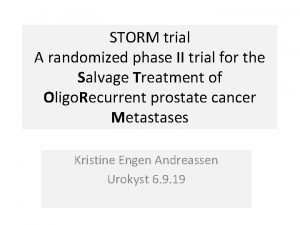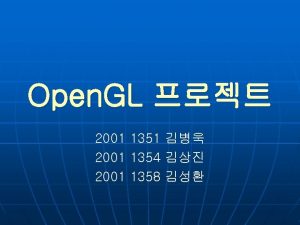NRGHN 2001 A phase II trial of using












![Correlative Science [The Dream] • Correlate pre-treatment tissue (WES, EBV Sequencing, RNA Seq [Immune Correlative Science [The Dream] • Correlate pre-treatment tissue (WES, EBV Sequencing, RNA Seq [Immune](https://slidetodoc.com/presentation_image_h/e0ca04a9d73a1e2e313b32c2cbb9b0ec/image-13.jpg)
- Slides: 13

NRG-HN 2001: A phase II trial of using plasma EBV DNA to direct adjuvant therapy for high risk nasopharyngeal carcinoma after definitive treatment PI: Nancy Y. Lee, MD, FASTRO NRG Oncology Virtual Summer Meeting July 17, 2020 @NRGOnc NRG Oncology

Enrolled 626 N= 346 N= 99 High Risk Cohort Completed 10/2020

Relevant Scientific Background • Since advent of IMRT for non-metastatic NPC, high locoregional control is achieved • Distant metastasis is can be as high as 17% to 30% across all published series and is the predominant cause of patient death • T-, N- is limited in their determination of treatment outcomes • Detectable EBV DNA after definitive treatment that includes radiation consistently have shown to be the most robust poor prognostic marker of survival • A recent meta-analysis of almost 11, 000 patients showed that detectable post-treatment plasma EBV DNA accounted for 5. 43 fold increase in death versus the undetectable EBV DNA controlled for all other variables such as T, N stage

• N=23 eligible studies including 10, 732 patients • Pretreatment plasma EBV DNA level for OS was 2. 78 • Post-treatment plasma EBV DNA level for OS was 5. 43

JC Lin et al. ASCO 2018


1 Week Post Treatment Plasma EBV DNA

• KEYNOTE-028: ORR was impressive at 25. 9% (95% CI: 11. 1– 46. 3), with 26% of patients experiencing partial response (PR) and 52% of patients with stable disease (SD) • NCI-9742 (NCT 02339558): ORR for heavily pre-treated NPC was 20. 5% (CR = 1; PR = 8), 1 -year OS rate was 59% (95% CI, 44. 3 to 78. 5%), and 1 -year PFS rate was 19. 3% (95% CI, 10. 1 to 37. 2%) • 1 PCD 4989 g clinical trial: Objective response occurred in 22% with median of PFS 2. 6 months (range 0. 5– 48. 4), and median OS 6. 0 months (0. 5– 51. 6) in patients who received atezolizumab • Camrelizumab monotherapy: Objective response of 34% (95% CI: 24– 44) • Camrelizumab + Gem/CDDP as first line: Objective response in 91% (95% CI: 72– 97) with a median follow-up time of 10. 2 months (IQR 9. 7– 10. 8), but 3 or 4 toxicities is high at 87%.

Study Design/Schema PD 1/PDL 1 inhibitor Placebo Consider 2: 1 randomization

Primary Objectives Phase II: To determine whether adjuvant immunotherapy (anti-PD 1 or anti-PDL 1) versus observation will result in superior progression-free survival in patients with detectable EBV DNA after definitive treatment for non-metastatic nasopharyngeal carcinoma. Phase III: To determine whether adjuvant immunotherapy (anti-PD 1 or anti-PDL 1) versus observation will result in superior overall survival in patients with detectable EBV DNA after definitive treatment for non-metastatic nasopharyngeal carcinoma.

Statistical Analysis • Phase II: The 2 -yr PFS for the observation (control) arm is assumed to be 40%. It is hypothesized that the addition of 1 year of adjuvant immunotherapy (anti-PD 1 or anti-PDL 1) will improve the 2 -year PFS from 40% to 45. 7%, which is equivalent to a HR of 0. 60 under the exponential distribution assumption (i. e. median PFS from 18. 1 months to 30. 2 months). With a 1 -sided type I error rate of 0. 15, 85% power, the logrank test requires 66 PFS events from 112 randomized patients. • Phase III: The 2 -yr OS for the observation (control) arm is assumed to be 53%. It is hypothesized that the addition of 1 year of adjuvant immunotherapy (anti-PD 1 or anti-PDL 1) will improve the 2 -year OS from 53% to 66%, which is equivalent to a HR of 0. 65 under the exponential distribution assumption (i. e. median PFS from 26. 2 months to 40. 3 months. With a 1 -sided type I error rate of 0. 025, 90% power and two interim efficacy analyses based on the OF boundaries, the logrank test requires 231 OS events from 314 randomized patients. • 1: 2 (Placebo; Experiemental) randomization Ph II: 75 PFS events, 125 pts, 85% power, 1 -sided alpha=0. 15, HR=0. 60 Ph III: 260 OS events, 349 pts, 90% power, 1 -sided alpha=0. 025, HR=0. 65

Secondary Objectives Major Secondary objective(s): • • To compare the following between arms: Progression-free survival (phase III); Overall survival (phase II) Locoregional progression; Distant metastasis; Quality of life (general and physical well-being) along with PRO’s Acute and late toxicity profiles based on clinician-reported CTCAE, v. 5; Death during or within 30 days of end of protocol treatment
![Correlative Science The Dream Correlate pretreatment tissue WES EBV Sequencing RNA Seq Immune Correlative Science [The Dream] • Correlate pre-treatment tissue (WES, EBV Sequencing, RNA Seq [Immune](https://slidetodoc.com/presentation_image_h/e0ca04a9d73a1e2e313b32c2cbb9b0ec/image-13.jpg)
Correlative Science [The Dream] • Correlate pre-treatment tissue (WES, EBV Sequencing, RNA Seq [Immune deconvolution estimate immune cell fractions) with PFS and OS [Ideally, multiple biopsies if feasible] • Correlate serial plasma EBV DNA level with # of cycles of immunotherapy • Correlate serial plasma EBV DNA level with PFS and OS • Correlate PFS and OS with blood samples (EBV DNA, HLA type, TCR sequencing clonality and diversity)
 Phase 4 trial
Phase 4 trial Normal phase vs reverse phase chromatography
Normal phase vs reverse phase chromatography Hplc reverse phase vs normal phase
Hplc reverse phase vs normal phase Mobile phase and stationary phase
Mobile phase and stationary phase Stationary and mobile phase
Stationary and mobile phase Normal phase vs reverse phase chromatography
Normal phase vs reverse phase chromatography Line vs phase voltage
Line vs phase voltage Adsorption chromatography
Adsorption chromatography Phase to phase voltage
Phase to phase voltage Csce 441
Csce 441 Rms controller
Rms controller System.collections.generics
System.collections.generics Defrost using internal heat is accomplished using
Defrost using internal heat is accomplished using 2001: a space odyssey the sentinel
2001: a space odyssey the sentinel
